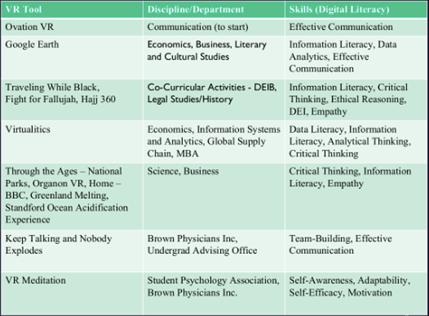Higher education institutions across the country are embracing new technologies to better equip their students with essential digital literacy skills. Potential employers expect graduates to have tech skills and higher education institutions often assume that students come into college already knowing the technology. The caveat is that even though today’s students are digital natives, this does not necessarily indicate that they are career tech ready. As today’s digital landscape continues to evolve, colleges and universities must rise to the challenge and accelerate their technology implementations to meet the current needs of students and faculty.
During Fierce Education’s recent virtual event, Higher Education: Business & Leadership Summer Edition, Laura Kohl, Director of Library Services of Bryant University, and Allison Papini, Assistant Director/Manager of Research & Instruction Services of Bryant University, shared their success with their virtual reality lab and how the school is incorporating new technologies to support students’ learning outcomes. To view the on-deman version click here.
Bryant University is a small institution of about 3,500 students and the university prides itself on its culture of innovation. The academic library is the hub of innovation as information technology evolves and the library works with liaisons for each department on campus, creating opportunities to apply new technologies to best support student learning.
The university launched their virtual reality lab, also known as a data visualization lab in April of 2019 and the academic library took over management, marketing, and training of the lab in 2022. Within the past academic year, the lab has seen increased engagement with faculty and students. The lab also received a grant from the Office of Library and Information Services of Rhode Island to upscale the VR system.
Bryant’s data visualization lab provides immersive experiences for students to build essential tech skills. Below is a table Khol shared to illustrate how the lab uses different VR tools in varying disciplines to strengthen digital literacy skills among students.

Kohl shares that by using Ovation VR, students are able to practice speaking in front of live audiences and can receive feedback on their speech and develop effective communication skills. The lab also uses Google Earth to provide an immersive experience for students who may not be able to travel abroad. Students can visit different places around the globe and experience the infrastructure of any given location (buildings, public transportation, etc.). In an economics class, this kind of VR can be used to allow students to compare different cities and problem solve in a way that would be unavailable without this tech. Furthermore, Khol highlights Traveling While Black, a VR tool that is used to help students develop critical thinking, ethical reasoning, and promotes diversity, equity, and inclusion in education.
The data visualization lab was given a grant to purchase 20 Meta Quest 2 headsets with new tools including a language lab. In the coming academic year the school and library will be partnering with Arbor XR for device management and instruction. They’re also looking forward to content creation by faculty and staff where more experimentation with augmented reality can take place.
While applying cutting edge technology can be exciting, Kohl and Papini acknowledge that many in the field are wary of what some advances in the digital landscape means for higher education. The rise of ChatGPT, for instance, has accelerated at an alarming rate and the field of higher education is just beginning to discover the impact this new tech will have on the industry. Professional development and campus wide conversations are essential in planning for the next academic year.
Papini shared that viewing generative AI from an information literacy framework can help professionals guide themselves and students through this new tech:
- Research as Inquiry: generative AI can help students learn how to frame questions
- Searching as Strategic Exploration: using ChatGPT to learn how to generate keywords, determine what type of source is needed
- Authority is Constructed and Contextual: students and faculty must consider the source
- Information Creation as a Process: using generative AI experimentally helps learning to become more experiential and less transactional
- Information Has Value: ChatGPT raises considerations of ownership and ethics
- Scholarship as Conversation: finding related works
ChatGPT is great for certain circumstances and professionals can harness its many uses. Papini shares her experiences with Research Rabbit, a generative AI tool that finds similar research works based on uploaded works. This kind of tool can help students build momentum for their research projects and help them get past writer's block.
Papini urges professionals in the field to encourage their students to explore and be creative with this new tech. Banning the use of generative AI can potentially be harmful for students' careers because future employers will look for some level of proficiency. The goal is for students to be prepared and able to use generative AI responsibility, ethically, and effectively.
Ultimately, educators must research and read up on the implications and uses of AI. Kohl and Papini remind us that university librarians are there to help students and faculty tackle these new technologies and harness their potential.
For more articles from Fierce Education’s virtual event, see:
Meeting the Academic and Mental Health Needs of Students
Better Preparing Students for the New Workforce